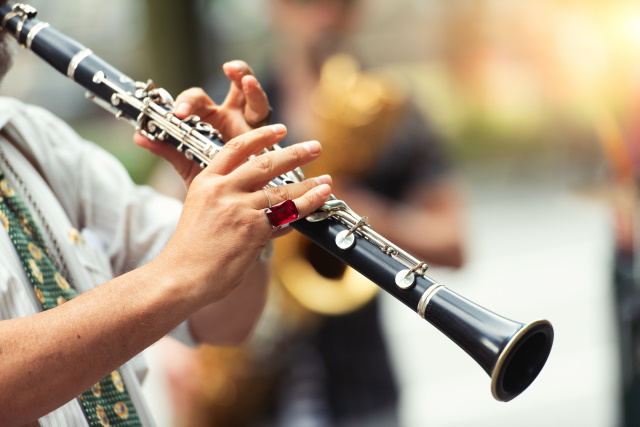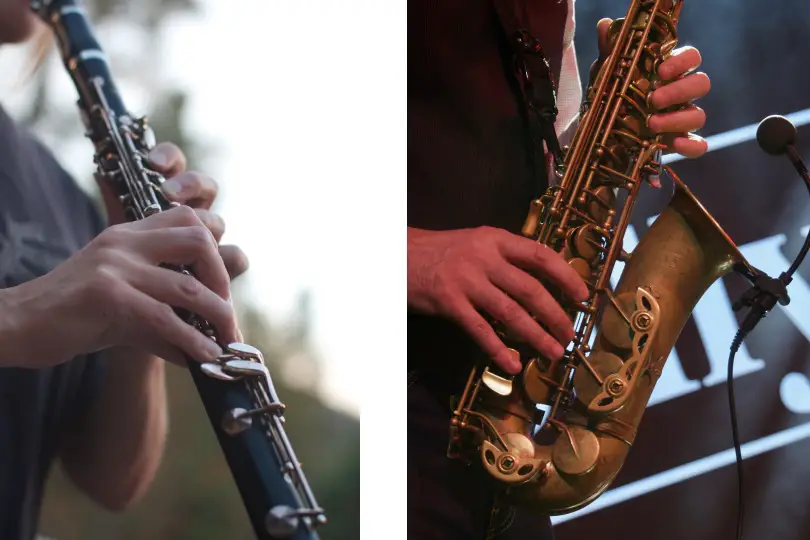The clarinet and the saxophone are both part of the woodwind family of instruments, and they have many things in common. A commonly asked question is, which one is easier to play?
The clarinet is generally considered harder to learn than the saxophone due to trickier fingerings, more sensitive embouchure, and the need to cover holes vs pressing keys. Clarinet is more delicate and requires more control. Playing saxophone for jazz, however, involves more advanced techniques.
While clarinet may be harder in general, both instruments have their own characteristics that make them easier or harder to play.
The clarinet has more fingerings to learn and it’s more difficult to “cross the break” between registers. Saxophone can be challenging initially because it’s bigger and heavier.
| WHICH IS EASIER? | REASON | |
| Embouchure | Saxophone | More relaxed embouchure |
| Fingerings | Saxophone | Keys vs open holes, fewer fingerings, octave register |
| Sound production | Clarinet | Low notes are harder to play on sax |
| Intonation | Clarinet | Sax has more notes needing adjustment |
| Repertoire | Tie | Orchestra music (clarinet) vs Jazz (sax) |
| Advanced techniques | Clarinet | Sax often uses vibrato, altissimo etc |
Table of Contents
Is saxophone similar to clarinet in terms of difficulty?

When Adolphe Sax set about inventing the saxophone in the 1840’s, he wanted to make something that combined the positive aspects of brass and woodwind instruments.
He was after an instrument that sounded like a woodwind instrument, but could project like a brass instrument.
Reed
Both the clarinet and the saxophone are single reed instruments. A reed is attached to a mouthpiece and when the player blows into the mouthpiece, the reed vibrates against it.
So they’re similar in how they make sound, although the angle of the mouthpiece is slightly different.
Because the clarinet mouthpiece is smaller than the saxophone mouthpiece, the reed is also smaller. Many believe it is for this reason that it’s harder to find good reeds for clarinet than it is for saxophone.
Embouchure
While the embouchure (how you use the muscles of your mouth to play a wind instrument) is almost the same between the two, you generally need to put more of the mouthpiece in your mouth for the saxophone.
The embouchure for the clarinet must be much firmer than for the saxophone. The muscles around the mouth must squeeze without biting, and the chin needs to be flat. This can make the embouchure more difficult to maintain on the clarinet.
For the saxophone, the embouchure is much more relaxed. The player needs to create a circle around the mouthpiece, keeping the muscles looser than for the clarinet embouchure. This is easier to achieve and maintain.
Fingering
Because the saxophone is modeled after woodwind instruments, the fingerings are nearly the same as the clarinet.
However, the saxophone changes register at the octave, so the fingerings are the same for the both of the main registers.
In contrast, the register change for the clarinet comes at the 12th, so there are more fingerings to learn for the two main registers.
Creating a sound: which one is easier?

As mentioned above, to produce a good sound, the embouchure must be much firmer for the clarinet than the saxophone. So it can be more difficult to create a quality sound on the clarinet.
The clarinet is also more likely to squeak when the embouchure isn’t correct. Squeaks generally happen due to an unsteady embouchure or incorrect fingerings.
Producing sound for the low notes is more challenging on the saxophone. It can take time to develop the skill needed to produce the low notes and make them sound good.
Fingerings: which one is easier?
While the fingerings for saxophone are generally easier, both instruments have their challenges.
Open vs closed hole
Fingerings for the clarinet are considered to be more difficult because the instrument has open holes, whereas the saxophone has keys to close the holes.
Fingering an open hole instrument like the clarinet means the player must be very precise in where each finger is placed in order to seal the hole. If there is any leak, the note won’t come out correctly, or the instrument will squeak.
On the saxophone, the player needs to know which fingers to put down, but they don’t need to be as exact in finger placement.
Range and register change
The saxophone has a smaller range than the clarinet. The high school range for alto saxophone is concert Db3 to Ab5 (or A5 if the instrument has an F# key), while the range for the Bb clarinet is concert D3 to F6.
Thus, the clarinet has quite a few more fingerings to learn.
As discussed earlier, there are fewer fingerings to learn on the saxophone because the fingerings basically repeat in the second register. All you need to do is add the octave key to the same lower register fingering.
On the clarinet, the fingerings are different because the instrument doesn’t change registers at the octave but at the 12th.
Crossing the break between registers on the clarinet can be difficult for learners. It involves moving from a fingering which opens all of the holes to a fingering which closes almost all of the holes.
It’s a challenge to close all of the holes smoothly at exactly the same time.
The clarinet is also different acoustically because it is basically cylindrical whereas the saxophone is conical.
Low notes
Fingering the low notes can be a challenge on the saxophone because the keys are harder for the pinkies to push down.
On the clarinet, the keys are fairly small and easy to press down, while on the saxophone the large key mechanism can be unwieldy. Hence, hitting the lowest notes can be hard, particularly for a small-handed player.
Intonation: is sax or clarinet easier?
Playing in tune can be challenging on both instruments. It’s really a life-long objective to make the minute adjustments needed to do so.
For any instrument, it’s very important that it plays as close to in tune with itself as possible. The mouthpiece also plays a part in intonation. On the clarinet, the barrel is also important.
Just like all instruments, the clarinet and the saxophone have their own individual pitch tendencies. These can be adjusted in a number of ways, including breath support, embouchure and alternate fingerings.
The saxophone is considered to have more notes that need additional adjusting since it doesn’t play in tune with itself as well. These types of adjustments require that the player develop a good ear for intonation.
Adjusting isn’t just a matter of pressing the right key or closing the right hole to play in tune. The player must be able to distinguish slight differences in pitch for each note. They can then adjust by changing the embouchure and tongue position.
Mastering the instrument: which is easier?
Clarinet vs sax: technique
For the intermediate and advanced clarinetist, it’s important to continue developing technique.
In a band, the clarinets are often given the parts that violins would play in an orchestra, so there are frequently fast-moving passages which require the clarinetists to play with solid technique.
While intermediate and advanced saxophonists also work on their technique, because the instrument has closed holes, it is somewhat easier to move around quickly on the sax.
Saxophones are used in jazz more often than clarinet, which typically involves:
- Additional scales and chord progressions
- Different tone quality, often using a different style of mouthpiece
- Playing in jazz style
- Glissando – continuous sliding from one note to another
Clarinet vs sax: tone quality
Clarinetists and saxophonists both strive to improve their tone quality constantly.
As mentioned earlier, the clarinet requires a firm embouchure without biting, a delicate skill to develop and maintain.
The saxophone requires a looser, rounder embouchure. Retaining the saxophone embouchure without moving or biting also takes control.
Other aspects involved in developing a good tone quality include tongue position and good breath support.
Musicality
Both the clarinet and saxophone can be incredibly expressive instruments. Both require experience listening to and performing music to understand the nuances of the different styles, and make the instrument really speak.
Additional techniques
Traditionally, the saxophone plays using vibrato, a slight variation in pitch which produces a warmer, richer tone. Vibrato is a skill which takes some effort to master.
The clarinet can play with vibrato, but it’s not expected very often.
The alto saxophone range extends to concert Ab5, but higher notes can be played by using what are called altissimo (Italian for very high) fingerings.
These notes are produced by using special fingerings and adjusting the embouchure and tongue position to play higher range notes. This is a special challenge for maturing saxophone players.
Clarinet vs sax repertoire: which is easier?
As musicians advance in skills, the music typically performed on the sax and the clarinet tends to diverge .
Both instruments have Classical music written for them, but the clarinet has been in existence almost 150 years longer than the saxophone so there is much more original clarinet music written.
Namely, there is a wealth of orchestral music available for the clarinet. Playing clarinet in an orchestra requires astute musical and technical skills.
To make up for the smaller pool of written music, Saxophonists often play music originally intended for a different instrument, like the oboe or violin, and transcribed for the sax.
Besides classical, there is also a wide variety of contemporary compositions for advanced and professional clarinetists and saxophonists. Saxophone music, namely for jazz ensembles, can be especially demanding technically.
At such advanced levels, both instruments require extended techniques such as multiphonics, growling and even singing into the instrument while playing.
Final words
While the clarinet may seem harder, that doesn’t mean it isn’t fun to learn. It has a beautiful sound, a wide pitch range and is a standard member of the orchestra.
Many aspects of learning saxophone may be easier, but it has its challenges, too. It also sounds beautiful and is an important part of jazz ensembles.

